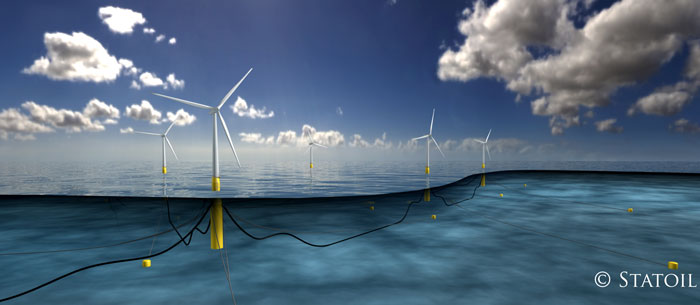
Can floating turbines operated further out at sea harness more wind power and improve the renewable energy sector?
This was the idea being explored and piloted off the coast of Norway in 2009 and after 6 years of successful operations the company behind that pilot, Statoil, took the decision to invest in building the world’s first floating wind farm in Aberdeenshire, Scotland.
They will be installing a 30 MW wind turbine farm on floating structures at Buchan Deep, 25km offshore of Peterhead. The turbines will harness the wind and provide energy to approximately 20,000 mainland homes. Supply of that electricity is anticipated to start towards the end of 2017.
The UK is already seen as a leader in wind power installations with some of the biggest wind farms in place. Earlier this year approval was given for Hornsea One. The multi billion pound project to build the world’s largest offshore wind farm is situated in the North East of England and is will have traditional turbines standing at 190 metres high. Offshore wind turbines are more difficult and costly to construct than onshore, but the growing objections towards onshore turbines has resulted in the government favouring offshore projects.
Fixed turbine projects often run into problems because of complexities in the sea bed. In contrast, the Statoil Hywind structures have no such problems. In addition, installing floating turbines is cheaper as they can be assembled at port side and then towed to their location; there is no need for the expensive heavy lifting vessels normally needed to construct and fix turbines to the seabed.
The Hywind structures are ballasted steel cylinders known as spar bouys which are then anchored to the seabed suing mooring lines. Each structure will have a turbine placed on top and pitch motion controllers help prevent too much movement. The structures can be used with any type of wind turbine which makes them very versatile.
According to Wind Europe, wind power is set to become the backbone of future power systems and it is anticipated that wind power could meet a quarter of Europe’s power demands by 2030. The sector currently accounts for more than 300,000 European jobs and 40% of all wind turbines sold globally.
Sources:
Helen Knight: theengineer.co.uk
statoil.com
This site uses Akismet to reduce spam. Learn how your comment data is processed.


 Mail:
Mail: 




Leave a Comments